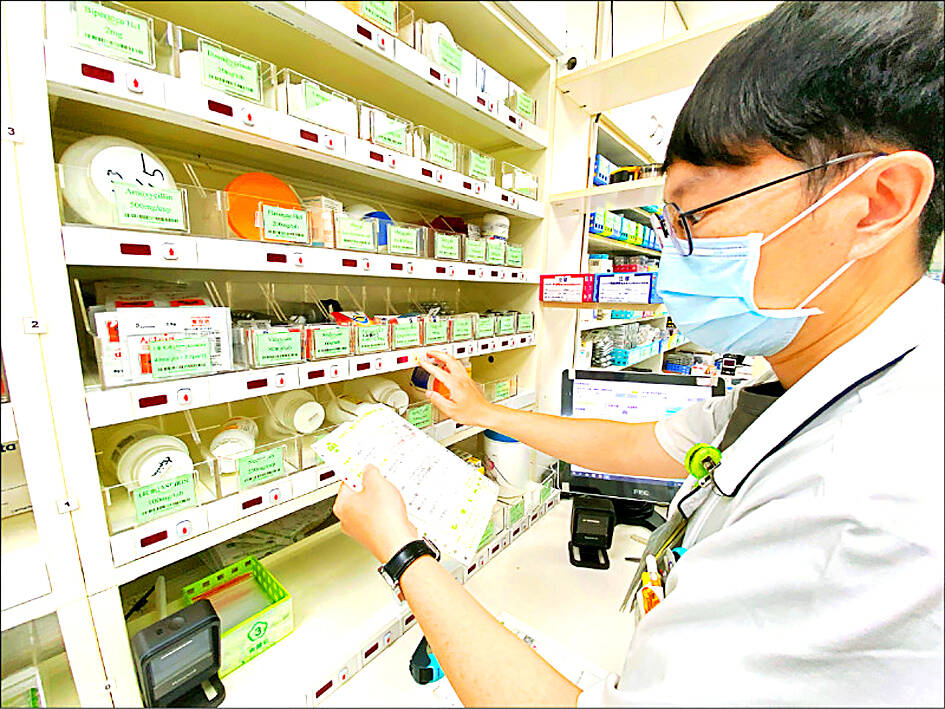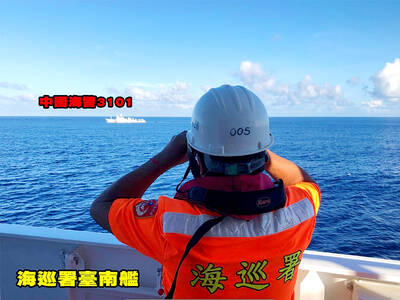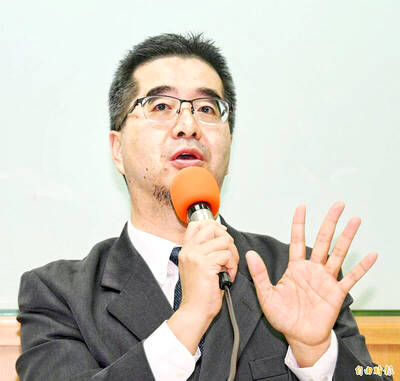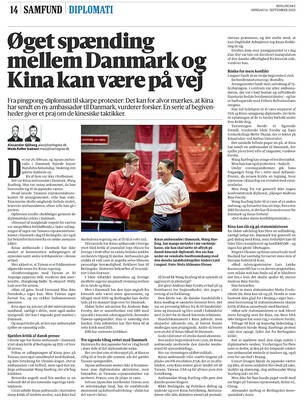Many of the nation’s large hospitals are running short of pharmacists, with some having a shortage of up to 30 percent.
According to data from the Ministry of Health and Welfare, there were 37,391 registered pharmacists as of the end of last year, with 19,994 working in pharmacies, while 17,278 worked in healthcare facilities.
During the COVID-19 pandemic, demand for masks and at-home rapid test kits had led to many people visiting community pharmacies, and many of them would buy other products while they were there, so overall sales increased by about 30 percent, Federation of Taiwan Pharmacists Associations president Huang Jin-shun (黃金舜) said.

Photo courtesy of the Tainan Municipal Hospital
At the time, some pharmacists left hospitals and opened their own stores, and the number of pharmacies increased from more than 7,000 to more than 8,000 across the nation, he said.
However, sales declined after the pandemic, and as the cost of hiring pharmacists is high, more than 300 community pharmacies had shut down, he added.
Taiwan Society of Health-System Pharmacists president Chang Yuh-lih (張豫立) said that pharmacist shortage is common in medical centers and regional hospitals, especially in northern Taiwan, where there are shortages of 5 percent to 30 percent.
While some pharmacy departments of hospitals in central and southern Taiwan are fully staffed, others still have a shortage of more than 10 percent, Chang said.
The difference in pharmacist shortages in northern and southern Taiwan could be because of differences in salary and cost of living, he said.
Many graduates of pharmacy departments in central or southern Taiwan previously would look for a job in northern Taiwan due to the higher salaries, but as the salaries in hospitals of central and southern Taiwan have increased over the past few years, and the cost of living in northern Taiwan is higher, many graduates go to central or southern Taiwan to work, he said.
National Taiwan University Hospital’s Department of Pharmacy director Huang Chih-fen (黃織芬) said they have not observed that pharmacists are returning to hospitals, and many hospitals still have pharmacist shortages.
The difficulty in recruiting pharmacists to hospitals stems from that the work there is more complicated, and that frontline prescription is fast-paced, high-volume and has many additional requirements such as educational training and hospital accreditation, Chang said.
As long as the salary and benefits are lower than in community pharmacies, hospitals would have difficulty recruiting or retaining pharmacists, he said.
Most pharmacists who left non-hospital workplaces would not return to hospitals, he added.
There are more patients with complicated conditions in hospitals, so pharmacists would need to constantly learn from training sessions and might need to train coworkers, so when the incentives are not enough, they could leave hospitals more easily, Huang said.
Deputy Minister of Health and Welfare Lin Ching-yi (林靜儀) said the ministry is pushing for reforming hospital pharmacies, hoping to reduce the staff’s workload by collaborating with pharmacies or integrating automated smart equipment into prescription and distribution work.
It would let pharmacists in hospitals focus on more complicated work, allowing them to demonstrate their professional value and be more willing to stay in their jobs, Lin said.
Meanwhile, the National Health Research Institutes’ projection for the pharmacy workforce, commissioned by the ministry, predicted that the supply of pharmacists would exceed demand in the future, and the number of pharmacists would increase to about 40,000 by 2032, but the shortage in medical facilities would increase.
The prediction was made using data from the Hospital Information System, statistics of students and graduates of pharmacy departments, the number of people who passed the national examination for pharmacist license, a survey on pharmacists’ work burden, and the National Health Insurance system.
The institute’s study also predicted that the number of annual prescriptions would increase from more than 280 million in 2022 to more than 360 million in 2032, and the number of registered pharmacists in the workforce would increase from more than 36,000 to more than 39,000 — from an average of 15.8 pharmacists per 10,000 people to 17.2 per 10,000 people.
However, it also predicted that the number of pharmacists aged 65 or older would increase from about 7,300 to 11,749, accounting for 19.9 percent to 29.8 percent of all pharmacists.
In addition, the ratio of pharmacist supply and demand would shift from minus-6.7 percent in 2022 to minus-13.7 percent in 2032 in medical centers, and from minus-0.4 percent to minus-12.4 percent in regional hospitals, it predicted.
As the supply of pharmacists is projected to exceed demand in the future, schools should not establish new pharmacy departments, the institute said.
As medical facilities continue to face pharmacist shortages, the government should encourage hospitals to improve their salary and benefits, help them relieve work stress, offer career development opportunities, and continue to encourage patients to seek medical attention at clinics and local hospitals to reduce the burden at large hospitals, it added.

The Coast Guard Administration (CGA) yesterday said it had deployed patrol vessels to expel a China Coast Guard ship and a Chinese fishing boat near Pratas Island (Dongsha Island, 東沙群島) in the South China Sea. The China Coast Guard vessel was 28 nautical miles (52km) northeast of Pratas at 6:15am on Thursday, approaching the island’s restricted waters, which extend 24 nautical miles from its shoreline, the CGA’s Dongsha-Nansha Branch said in a statement. The Tainan, a 2,000-tonne cutter, was deployed by the CGA to shadow the Chinese ship, which left the area at 2:39pm on Friday, the statement said. At 6:31pm on Friday,

The Chinese People’s Liberation Army Navy’s (PLAN) third aircraft carrier, the Fujian, would pose a steep challenge to Taiwan’s ability to defend itself against a full-scale invasion, a defense expert said yesterday. Institute of National Defense and Security Research analyst Chieh Chung (揭仲) made the comment hours after the PLAN confirmed the carrier recently passed through the Taiwan Strait to conduct “scientific research tests and training missions” in the South China Sea. China has two carriers in operation — the Liaoning and the Shandong — with the Fujian undergoing sea trials. Although the PLAN needs time to train the Fujian’s air wing and

The American Institute in Taiwan (AIT) put Taiwan in danger, Ma Ying-jeou Foundation director Hsiao Hsu-tsen (蕭旭岑) said yesterday, hours after the de facto US embassy said that Beijing had misinterpreted World War II-era documents to isolate Taiwan. The AIT’s comments harmed the Republic of China’s (ROC) national interests and contradicted a part of the “six assurances” stipulating that the US would not change its official position on Taiwan’s sovereignty, Hsiao said. The “six assurances,” which were given by then-US president Ronald Reagan to Taiwan in 1982, say that Washington would not set a date for ending arm sales to Taiwan, consult

A Taiwanese academic yesterday said that Chinese Ambassador to Denmark Wang Xuefeng (王雪峰) disrespected Denmark and Japan when he earlier this year allegedly asked Japan’s embassy to make Taiwan’s representatives leave an event in Copenhagen. The Danish-language Berlingske on Sunday reported the incident in an article with the headline “The emperor’s birthday ended in drama in Copenhagen: More conflict may be on the way between Denmark and China.” It said that on Feb. 26, the Japanese embassy in Denmark held an event for Japanese Emperor Naruhito’s birthday, with about 200 guests in attendance, including representatives from Taiwan. After addressing the Japanese hosts, Wang